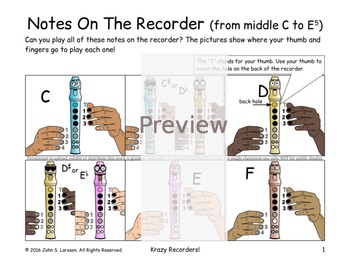
Octaves can be made smaller by placing wax in the bore where shown here:Į b2, E2, and F3 can sometimes be tuned up with wax at the top of the foot bore, but possible adverse effects on other notes should be checked. Octaves can be widened by placing wax in the bore where shown here: Place the wax in the right position, then apply a warm piece of metal to make it melt and adhere to the bore. This does not work for E b2, E2, F3 and G3, nor does it apply to F2, F#2 and G2, which are first register (fundamental) notes. It is possible to adjust octaves by putting wax inside the bore.Ī piece of wax positioned half way between the labium and the note's hole will reduce its octave relationship, while placing it close to the hole itself should enlarge it. A hole chart for recorders in C (soprano or descant, tenor).Other notes influenced by the same hole (which must be checked) F1 is the lowest F, F2 is the middle F, F 3 is the highest F, and so on. The note names carry a number corresponding to the octave they are situated in. They must be interpreted for working on other recorders. The following instructions are for a baroque type alto or treble recorder in f. Holes are numbered from 0 (the thumb hole) to 8 (the bell). It may also be necessary to open the opposite (windway) side). To lower a high note without changing its lower octave too much, put some wax in the bottom (bell) side of the hole.It may also be necessary to put some wax in the opposite (windway) side to reduce its diameter. To raise a high note without changing its lower octave too much, open the bottom (bell) side of the hole.

It may be also be necessary to open the opposite (bell) side).
#SIMPLE RECORDER FINGERING CHART HOW TO#
How to place a drop of wax in a hole (1), and spread it inside the undercutting (2). Use the same tool to spread the wax along the undercutting. Heat this on a flame, then touch the wax to melt it and pick up a drop which should quickly be placed it the right position inside the hole. This can be done with a small metal point like the handle of a needleįile. Wax can be used to reduce the size of a hole. This circular movement is made easier withįinish the job by cleaning the hole with small rolls of progressively finer grained abrasive paper (240, 320, 400). To the fibres, when it will start splitting the wood instead of cutting it. The top and bottom areas of the hole must be cut separately, beginning on one side and working around to the other, stopping before the blade gets parallel However, recorder makers usually use a narrow tuning knife, but this technique needs learning.Ī 3 mm double-bevelled blade is perfect for this.

Be careful to avoid the file "jumping" out and marking the instrument. Work at an angle in order to undercut the hole rather than cut it vertically. The safest tool for enlarging holes is a coarse round file.A fine file is inefficient on wood. To increase its diameter without moving it just enlarge it all around. To move a hole up or down the instrument, it is often sufficient to enlarge it on one side, and fill it in on the other side if necessary with a little beeswax. When retuning one particular note it is very important to watch the possible changes on all other notes depending on the same hole as shown in the table below.

This page explains techniques that can be used for simple tuning adjustments.


 0 kommentar(er)
0 kommentar(er)
